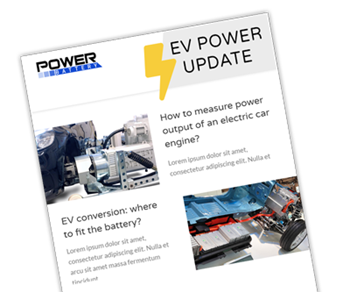Electric vehicle conversion using Tesla batteries
When starting an EV conversion with Tesla batteries, one of the parameters of the drive train is already decided. The Tesla batteries have certain fixed specifications such as dimensions, voltage, power output and capacity. In fact, you can use them as large building blocks for building the battery pack.
The upside of using a Tesla battery is that it is a known product with proven performance. The downside is that Tesla battery packs have a low voltage of 24V per module, therefore these aren't suitable for smaller applications. Second, these battery packs are sourced out of crashed or otherwise discarded Tesla’s. You cannot know exactly what happened with the battery packs during their lifetime. Also, Tesla prefers not to have their battery packs sold second-hand, so there are not many packs available. But, if you do get your hands on the battery pack(s) you need, building the complete battery pack is a bit cheaper.
Choosing the right Tesla battery pack
Tesla has three different car models on the market at present. There are only two different kinds of battery packs in their models. The Model S and Model X have the ‘small’ packs and the model 3 has the ‘large’ packs.
- The small battery pack has the following dimensions: 68,5 x 30 x 75 cm (lxwxh).
- The large battery pack has the following dimensions: 185,4 x 29,2 x 9 cm (lxwxh).
The new large battery of the model 3 is about three times longer than the older small battery pack module. The small pack is the most obvious choice for your EV conversion because of the dimensions. Unfortunately, these battery packs are not used in new Tesla cars anymore and therefore they aren't widely available.
Designing the battery pack
When you have decided which kind of battery pack you want to use, it is time to design the complete battery pack. Each battery pack has a certain voltage, capacity, and power output. The voltage of the other components in your drivetrain determines how many packs will need to be connected in serial. The power total output is determined by the amount of battery packs that are connected in parallel.
A lot of batteries are already connected in parallel inside the Tesla packs. In most cases, the power the battery pack can deliver when the individual packs are connected in serial, will be sufficient for the application. When this will not give you enough power or if you are not satisfied with the capacity, you can connect additional series of Tesla packs in parallel to increase the capacity and power output. Provided the resulting battery pack still fits in your application, of course.
A few things to keep in mind
- The individual battery packs have cooling channels inside them. You do not have to use these, but when you want a longer lifetime of your batteries and/or more power available, we recommend connecting a cooling system to these channels. You can also add a heating element to this circuit, to heat the battery pack when the temperature is low.
- There is a Battery Management System integrated in the battery pack modules. You certainly want to use this, but it is locked by Tesla. There are a few companies that have ‘hacked’ their way into these systems. These companies offer a PCB which replaces the original PCB on the module. Now you can use the battery management system of your own choice.
- The modules are purely made to fit in the Tesla vehicles. When designing the battery pack, there will be a lot of restrictions. You will probably need to do a lot of concessions to make it all fit inside your vehicle.
- Yes, secondhand Tesla battery packs are a lot cheaper than other brand-new battery packs. But the question remains if you really want to use secondhand battery packs with an unknown history.
Custom advice for your EV project
In short, choosing the right battery for your electric vehicle can be quite a challenge. Choosing a secondhand battery involves certain risks due to the unknown history. Also, important parameters such as dimensions, voltage, power output and capacity are already decided for you.
At Power Battery we develop, test and produce high-power battery packs and modules. Please contact us if you have any questions regarding your project, or request consultation.

